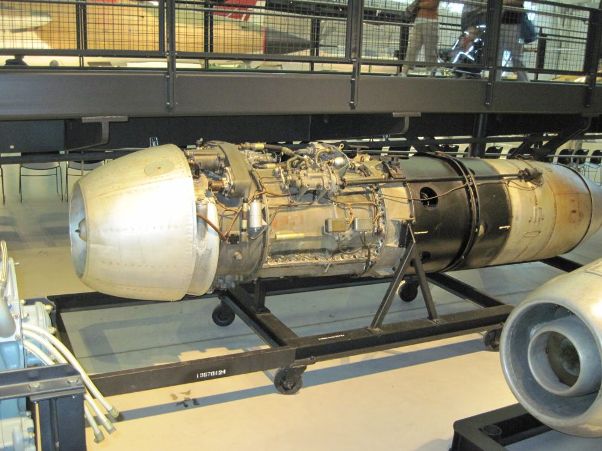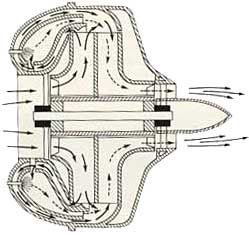| Junkers Jumo 004 Turbojet |

| ||
|---|---|---|---|
| |
| ||

The Junkers Jumo 004 was the first axial-flow turbojet. |
|||
|
| |||
|
On March 15, 1942, a Junkers Jumo 004 prototype was tested on a Messerschmitt Bf 110 making it the world’s first successful axial-flow turbojet engine. It would be the first jet engine to go into volume production and would power the world’s first operation jet fighter, the Messerschmitt Me 262, and the world’s first operational bomber, the Arado Ar 234.
After the demonstration of the HeS-3B centrifugal jet designed by Hans von Ohain in 1937 proved that turbojets was a viable technology, the German Ministry of Aviation (Reichsluftfahrtministerium or RLM) approached engine makers to produce turbojets of their own design. Junkers already had a turbojet program at the same time as Heinkel, but had abandoned the project. Junkers Motoren (Jumo), Daimler-Benz, Bramo and BMW began developing turbojet engines and in the end only Junkers and BMW engines would actually go into production. | |||
| Although Heinkel had developed Hans von Ohain’s experimental HeS-1 (Heinkel-Strahltriebwerk, or Heinkel Jet Engine) centrifugal turbojet engine into a working model, (The HeS-3B powered the Heinkel 178) the RLM preferred having established engine makers work on turbojet engine development. Heinkel’s first foray into engine development was the turbojet and possessed no production facilities to produce engines. In order to continue turbojet development and procure military contracts, Heinkel acquired Hirth Motorenwerke in 1939. |
| Meanwhile at Junkers, development restarted in 1939 under the direction of Anselm Franz. Since Junkers was primarily concerned with building piston engines, he began with a handful of engineers. His team would eventually grow to 500 by 1944. Junkers had a previous turbojet program in 1935, led by Herbert Wagner, but the engine would not run under its own power and the project was abandoned. Junkers asked Franz to take over the project, but he refused and opted for a design that was revolutionary compared to previous centrifugal-flow turbojet designs. The compressors of centrifugal turbojets are easier to construct, but they use reverse-flow air through the combustion section, which creates drag. Franz decided to create an axial-flow turbojet, which had a smaller cross-section, and also allowed air to flow straight through the engine, thus creating less drag. The smaller cross-section and more efficient air flow would allow an aircraft to travel at a greater speed. The project was given the designation 109-004 by the RLM. |
 |
 |
||
| Axial-flow turbojet with straight airflow. |
Centrifugal-flow turbojet with reverse airflow. |
|
He began with the 004A prototype, which would be similar to the final product, but without considerations for weight savings. There was also no restriction in the use of strategic materials. High alloy metals were used for all high-temp engine parts. The engine consisted of three main components, the compressor, combustor and turbine. Individual testing of each component was preferred, but due to the lack of time, a complete engine would be required. Based on the results obtained by the 004A, the production version 004B would be designed. The first test run of the 004A was conducted on October 11, 1940 and was run to 9,000 rpm and produced a thrust of 946 lbf (4.20 kN). After a change in the stator vanes, thrust was increased to 1,320 lbf (5.87 kN) and in December 1940, 2,200 lbf (9.78 kN) thrust was produced during a 10-hour run. Jumo 004A-0 engines were installed on the Messerschmitt Me 262 V3 prototype for its first Jumo powered flight on July 18, 1942.1
Development progressed slowly as the compressor and turbines of jet engines are very complicated with delicate components operating under high physical forces. Metal temperatures within an engine can reach as high as 1,800° F (982° C) and there was a shortage of precious alloys such as nickel, cobalt and molybdenum. Today, titanium is used for compressor blades and high percentages of cobalt, nickel and chromium alloys for exhaust turbines, to withstand the extreme temperatures and stresses produced by jet engines.2 Although the metallurgy was understood at the time, the alloys just weren't available in sufficient quantities. These alloys were scarce and mild steel (SAE 1010) was substituted in series production engines. The engine utilized a two-stroke engine as a starter which was built into the nose-cone of the engine that developed 10hp at 6,000 rpm. The starting engine had its own electric starter, plus a pull cord for emergency starts. The Junkers Jumo 004 engine had a single eight-stage compressor with enameled steel stator blades. On early engines, the first two stages of stator blades were aluminum, with the remainder being mild steel. On the later engines, the stator blades were converted to all steel. The first two stages had 27 rotor blades and 38 in the rest. The rotor blades were all stamped aluminum with machined roots fitting into pyramid shaped slots in the rotor disk. An annular combustion chamber would have been preferred, but to reduce complexity, six separate combustion-cans were installed. A short flame was necessary and the primary air was introduced into the chamber with a swirl and fuel was injected against the airflow to provide complete burning of the fuel/air mixture. The combustion chambers were made from mild sheet steel with an aluminum coating to protect against oxidation.3 The turbine and stator blades on the 004A were of solid material, but the production blades on the 004B were hollow. Two types of hollow blades were produced; a Krupp alloy Tindur, deep drawn blade of 30% nickel, and a nickel free Cromadur blade, made of folded sheet metal that was welded at the trailing edge. The Cromadur blade was somewhat more reliable and easier to produce and used less than five lbs. of chromium. The turbine blades were cooled by bleed-air from the 4th and last stage of the compressor. Cooling air was also bled off between the compressor and combustion chambers. Since the heat resistance of these alloys was below what was required, the average life span of production engines was 25 hours. Overhauls were required after 10 hours.4 If the alloys had been available as required, this would have extended engine life. Engines were tested up to 150 hours in actual flight tests and up to 500 hours on the test stand.5 Initial production began in 1942 with an order for eighty 004A engines, but these were to be used for testing only. They were not suitable for flight because they were too heavy (850 kg/1,870 lbs) and they used high amounts of strategic materials, such as nickel, cobalt, molybdenum, etc. On the 004B, almost all the hot metal parts were changed to mild steel with an aluminum coating. Weight on the 004B was reduced to 1,650 lbf (7.40 kN) and the strategic materials used was less than half of the A series. The 004B was also a modular design for ease of production. The 004B-1 produced a thrust of 2,000 lbf (8.90 kN) and ran primarily on diesel fuel. Gasoline was used for the two-stroke starter motor and for starting the turbojet. A combination of gasoline and diesel was used after starting and then to all diesel fuel.6 Deliveries began in June 1943, but turbine failures were encountered due to resonance vibrations at full speed. The problem was solved by increasing the natural frequency of the blade, (increasing the blade taper) and reducing the speed from 9,000 rpm to 8,700 rpm. Full production was not achieved until early 1944, which delayed the introduction of the Messerschmitt Me 262. The model 004E was the first turbojet equipped with an afterburner. Extra fuel was injected just before the turbine stator vanes and the exhaust temperature increased to 1,600° F (870° C) and thrust increased from 2,200 lbf (9.80 kN) to 2,640 lbf (11.75 kN). It was scheduled to go into production in 1945. More than 5,000 Jumo 004 engines were produced before the end of the war. After the war, Dr. Anselm Franz would work for Lycoming and developed the T53 and T55 turboshaft engines. |
| Specifications: | Junkers Jumo 004 | Date: | 1942 | Type: | Turbojet |
|---|---|
| Compressor: | Single-spool 8-stage axial-flow | Combusters: | Six burner cans | Turbine: | Single-stage |
| Length: | 152 in (3.86 m) |
| Diameter: | 32 in (.810 m) |
| Thrust: | 1,980 lbf (8.8 kN) |
| Dry Weight: | 1,585 lb (719 kg) |
Endnotes:
|
1. Walter J. Boyne and Donald S. Lopez, ed. The Jet Age, Forty Years of Jey Aviation. Washington, D.C.: Smithsonian Institution Press, 1979. 70-71. 2. Jack V. Casamassa and Ralph D. Bent. Jet Aircraft Power Systems. New York: McGraw-Hill Book Company, 1957. 292-299. 3. Dr. Daniel Uziel. Jet Engine Development in Germany. November 17, 2012. http://thefutureofthings.com/column/5887/jet-engine-development-in-germany.html 4. J.R. Smith, Antony L. Kay, E.J. Creek. German Aircraft of the Second World War. London: Putnam, 1985. 44. 5. John Forster Jr. ed. Design Analysis of the Me-262 Jet Fighter, Part II-The Power Plant. Aviation. November 1945. 115. 6. Lt. R. M. Salter Jr. and Lt. Comdr. G. G. Emerson. Power Plant Memorandum No. 12, German Turbo-jet Development. Washington: Navy Department Bureau of Aeronautice, June 1945.
© Larry Dwyer. The Aviation History Online Museum. All rights reserved. Created September 3, 2013. Updated June 8, 2015. |